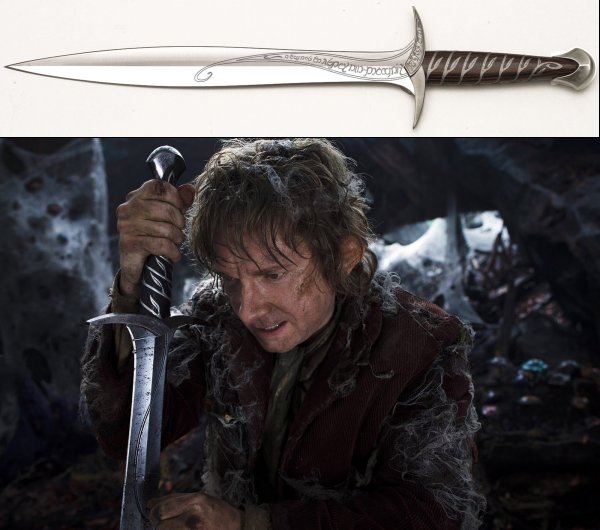Q: Should the Sword Sting Have an Inscription?
ANSWER: Short answer, no. Let me quote the entire question as I received it:
It has come to my attention that “Sting” has an inscription on it in Sindarian. “Sting is my name; I am the spider’s bane.” This seems odd to me as the sword was made in first age Gondolin, but didn’t fight any spiders until the third age in mirkwood… did Turgon even honor Thingol’s Noldorin ban on language? Could you shed a little light on Stings Inscription? Did Bilbo have it inscribed? if so by who. Gil-Galad and Elrond were both Noldor and surly Thingol’s ban on that language would have passed with him. So why Sindarin, provided Bilbo did ask Elrond to inscribe it? It should make for an interesting post.
So, really, there are a lot of questions bound up in this one question. Let’s run through them in order.
Did Turgon even honor Thingol’s Noldorin ban on language? Yes, Turgon’s people honored the ban. We read in The Silmarillion that…
…And it came to pass even as Thingol had spoken; for the Sindar heard his word, and thereafter throughout Beleriand they refused the tongue of the Noldor, and shunned those that spoke it aloud; but the Exiles took the Sindarin tongue in all their daily uses, and the High Speech of the West was spoken only by the lords of the Noldor among themselves.
This is not the only passage that is evidence. For example, the stories of Hurin and Huor, and of Tuor — all of whom grew up speaking Sindarin as their primary language — show that they were able to speak with Turgon and his people. Many of Turgon’s people were Sindar (Voronwë’s mother was of the Sindar, for example), and he would not have angered them by ignoring Thingol’s law. Any inscriptions written on swords made in Gondolin quite probably would have been made in Sindarin, especially if they used the Cirth, which Daeron devised for his own language. The Noldor brought swords from Aman and if they had inscriptions those would have been written in Tengwar in Quenya.
Could you shed a little light on Stings Inscription? Did Bilbo have it inscribed? In the books Sting has no inscription. The inscription you see on the sword in the “Lord of the Rings” is the one you see on the replicas that have been sold over the past decade. In “The Hobbit: An Unexpected Journey” I see no inscription on Sting.


I would assume that Peter Jackson is implying that Bilbo had Sting inscribed while he was living in Rivendell. Perhaps one of the Brian Aldiss companions to the movies explains the inscription. I am afraid I have never bought any of the books and the one book that was given to me as a gift has been lost.
So why Sindarin, provided Bilbo did ask Elrond to inscribe it? It should make for an interesting post. Well, I don’t know how interesting the post would be but I think that Elrond (who was descended from both the Sindar and the Noldor) would have used Sindarin as his every day language. Sindarin became the common language of western Middle-earth after Thingol’s decree and remained so until the end of the Second Age. The Numenorean-based Westron did not become a true common language until the Third Age, probably within a few centuries of Sauron’s downfall.
Also, if the smiths of Rivendell wished to be consistent with the practices of Gondolin, then they would most likely choose to make an inscription in Sindarin. What I find strange, however, is that the artists at Weta chose to use Tengwar for the inscription rather than Cirth. I don’t recall their ever asking me about how the inscriptions should be made. I think I would have advised them to use Cirth (and perhaps they did ask but decided to use the more elegant Tengwar anyway). Unfortunately, I lost all those emails in a hard drive crash years ago so I have no way of going back to check.
See also:
- How Could the Great Goblin Recognize Glamdring and Orcrist?
- How Did Glamdring, Orcrist, and Sting End up in the Trollshaws?
- Should Glamdring Have Been Named in Sindarin or Quenya?
# # #
Have you read our other Tolkien and Middle-earth Questions and Answers articles?

Or maybe Bilbo asked for it to be in Tengwar for the same reason – it was prettier. It sounds more like something a Hobbit would write than an Elf, so I would imagine it was his idea. After all, he had plenty of time to personalize his sword.
Glorfindel’s (who lived in Rivendell) “mae govannen” to Aragorn (who grew up in Rivendell) confirms that Sindarin was most likely spoken in Rivendell, yes.
Glad I’m getting notices of your blog postings now, as I find this very interesting! I did notice that the inscription doesn’t appear on versions of Bilbo’s sword in *The Hobbit* (and even United Cutlery features two versions of Sting – Bilbo’s is without the inscription, and Frodo’s has it), so it does seem that the filmmakers have recognized that to include the inscription on the sword in *The Hobbit* films would be anachronistic. Thank you for posting this!